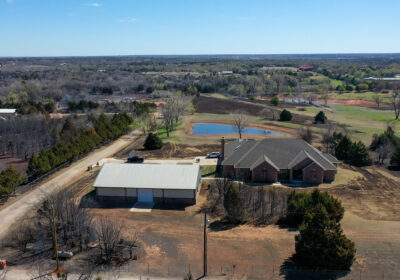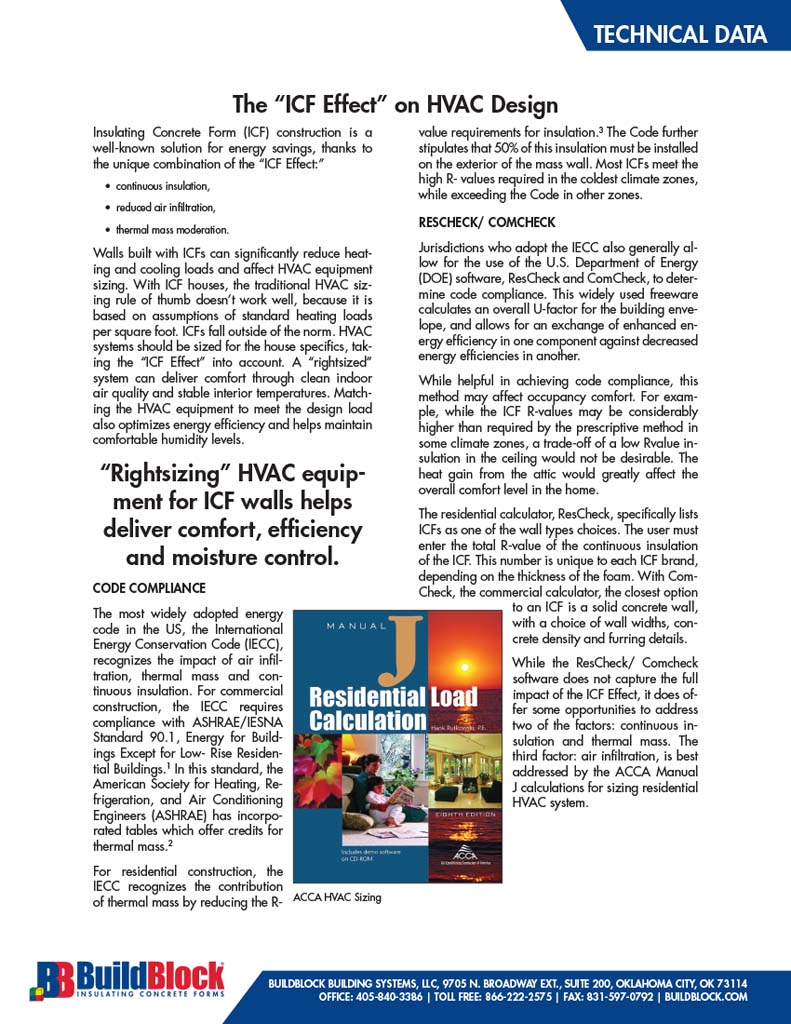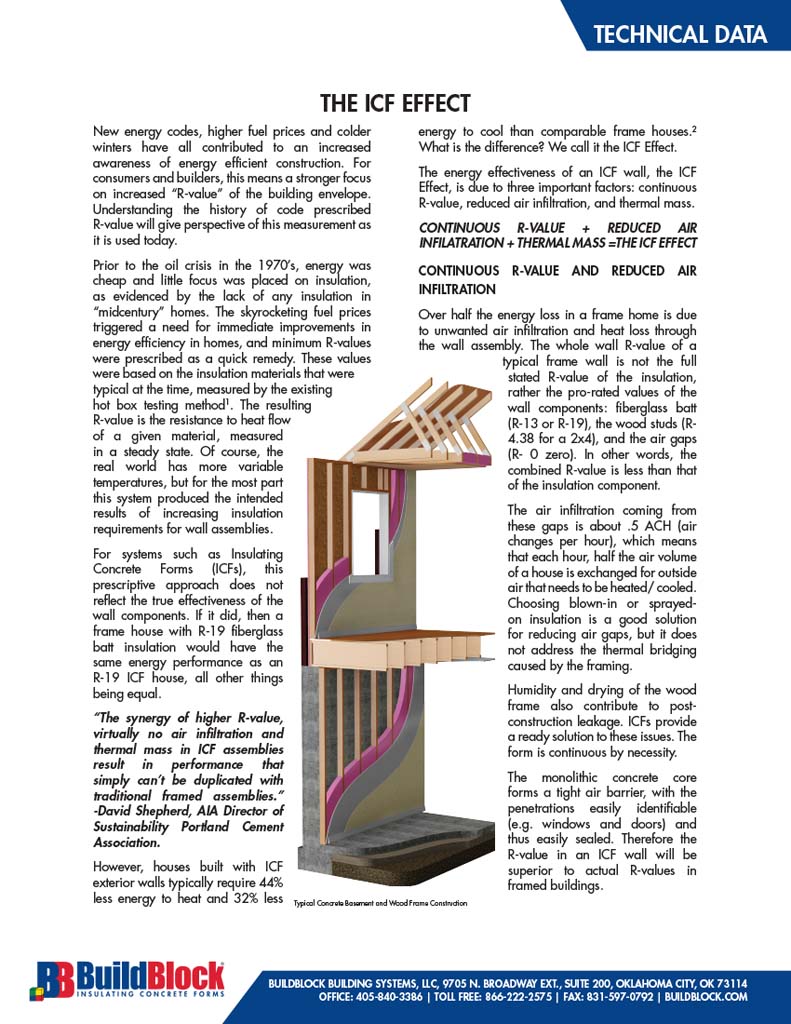White Paper: The ICF Effect
Continuous R-Value, reduced air infiltration and thermal mass all make up the ICF Effect
New energy codes, higher fuel prices, and colder winters have all contributed to an increased awareness of energy efficient construction. For consumers and builders, this means a stronger focus on increased “R-value” of the building envelope. Understanding the history of code prescribed R-value will give perspective of this measurement as it is used today.
Prior to the oil crisis in the 1970’s, energy was cheap and little focus was placed on insulation, as evidenced by the lack of any insulation in “midcentury” homes. The skyrocketing fuel prices triggered a need for immediate improvements in energy efficiency in homes, and minimum R-values were prescribed as a quick remedy. These values were based on the insulation materials that were typical at the time, measured by the existing hot box testing method1. The resulting R-value is the resistance to heat flow of a given material, measured in a steady state. Of course, the real world has more variable temperatures, but for the most part, this system produced the intended results of increasing insulation requirements for wall assemblies. For systems such as Insulating Concrete Forms (ICFs), this prescriptive approach does not reflect the true effectiveness of the wall components. If it did, then a frame house with R-19 fiberglass batt insulation would have
“The synergy of higher R-value, virtually no air infiltration and thermal mass in ICF assemblies result in performance that simply can’t be duplicated with traditional framed assemblies. Performance that simply can’t be duplicated with traditional framed assemblies.” – David Shepherd, AIA Director of Sustainability Portland Cement Association.
However, houses built with ICF exterior walls typically require 44% less energy to heat and 32% less energy to cool than comparable frame houses.2 What is the difference? We call it the ICF Effect. The energy effectiveness of an ICF wall, the ICF Effect, is due to three important factors: continuous R-value, reduced air infiltration, and thermal mass
Continuous R-Value and Reduced Air Infiltration
Over half the energy loss in a frame, home is due to unwanted air infiltration and heat loss through the wall assembly. The whole wall R-value of a typical frame wall is not the full stated R-value of the insulation, rather the pro-rated values of the wall components: fiberglass batt (R-13 or R-19), the wood studs (R-4.38 for a 2×4), and the air gaps (R- 0 zero). In other words, the combined R-value is less than that of the insulation component. The air infiltration coming from these gaps is about .5 ACH (air changes per hour), which means that each hour, half the air volume of a house is exchanged for outside air that needs to be heated/ cooled. Choosing blown-in or sprayed-on insulation is a good solution for reducing air gaps, but it does not address the thermal bridging caused by the framing.
Humidity and drying of the wood frame also contribute to post-construction leakage. ICFs provide a ready solution to these issues. The form is continuous by necessity. The monolithic concrete core forms a tight air barrier, with the penetrations easily identifiable (e.g. windows and doors) and thus easily sealed. Therefore the R-value in an ICF wall will be superior to actual R-values in framed buildings.
“The new ENERGY STAR Qualified Homes Specifications effectively level the playing field between framed construction and advanced wall systems like insulating concrete forms. This is because complete air barrier assemblies that have often been missing in framed construction, but are standard with advanced wall systems, are now required in every labeled home.” -Sam Rashkin, National Director, ENERGY STAR for Homes, The United States Environmental Protection Agency
Thermal Mass The benefits of thermal mass have been enjoyed by many cultures for centuries, and have now also been acknowledged by the scientific community. Studies conducted by the Department of Energy (DOE), the U.S. Department of Housing and Urban Development (HUD), and the National Institute of Standards and Technology (NIST) have confirmed that mass in exterior walls reduces annual energy costs in buildings. This data was used first by the Council of American Building Officials (CABO) 1987 Model Energy Code (MEC) in the form of a thermal mass credit table, which was then incorporated into the International Energy Code (IECC), as reduced R-values required for mass walls.
ICF walls demonstrate characteristic thermal mass qualities including heat absorption and thermal lag. The additional insulation on the interior of an ICF wall further delays the transfer of heat to the inside of the building. While this differs from a traditional passive solar application, it serves to moderate indoor temperature swings and reduces the amount of heating/ cooling needed. Passive solar designs can then easily fill the remaining exposed thermal mass needs through interior walls or mass floors. The thermal lag delays heating or cooling demands, which reduces and delays the peak loads to take advantage of off-peak energy pricing and allows for down-sizing of HVAC equipment. In climates with temperature swings, the mass wall can release the absorbed heat energy to the cooler night air, a process called heat Flow reversal.
These three factors play a large part in the energy efficiency of any home, but in an ICF home, these factors are key to maximize energy efficiency.
1 American Society for Testing and Materials Designation: C976, consists of three basic parts: an outdoor chamber, an insulating frame that surrounds the test wall, and an indoor chamber. Temperatures in the outdoor chamber can be maintained at a constant (steady state) level or they can be varied to follow a predetermined time-temperature (dynamic) cycle.
2 RP119 VanderWerf “Energy Comparisons of Concrete Homes Versus Wood Frame Homes”
3 Mass walls…. shall be considered walls of concrete block, concrete, insulated concrete form (ICF)… The provisions of Section 402.1.1 for mass walls shall be applicable when at least 50 percent of the required insulation R-value is on the exterior of, or integral to, the wall.
This information provided by the Insulating Concrete Form Association (ICFA). The Insulating Concrete Form Association (ICFA) is the business association of the insulating concrete form industry, representing over 460 international firms through ICF promotion, codes and standards, research, partnering and education.
Source:
This information provided by the Insulating Concrete Form Association (ICFA). The Insulating Concrete Form Association (ICFA) is the business association of the insulating concrete form industry, representing over 460 international firms through ICF promotion, codes and standards, research, partnering and education. This document was originally published by the Insulating Concrete Forms Association in 2008. It has been revised in 2015.
Related Posts

Construction Starts for the First Home of Nicor Gas’ “Smart Neighborhood” Using BuildBlock ICFs
Aurora, IL, July 10, 2025— Kicking off a groundbreaking step toward sustainable housing, Nicor Gas and Habitat for Humanity have officially begun construction on Habitat Green Freedom—an ambitious initiative utilizing BuildBlock Insulating Concrete Forms (ICF) to build disaster-resilient, net-zero homes that redefine affordable living.The first house project is located at…

Wall Parging for ICF Construction: What It Is, Why It’s Needed, and How to Do It Right
If you're working with Insulated Concrete Forms (ICFs), one question always comes up: how do you finish that exposed foam between the ground and your siding? The answer is wall parging—a critical step that not only protects your build but also enhances its curb appeal.

Built to Withstand: How ICFs Play a Critical Role in Fire Resilient Construction
In 2023, Oklahoma City faced a devastating wildfire season, with 97 recorded blazes destroying 76 structures and winds reaching 50-60 MPH. Amidst this destruction, one home stood resilient: BuildBlock Founder Mike Garrett’s ICF (Insulated Concrete Form) home.


